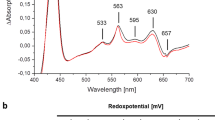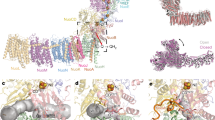Abstract
Cell respiration is catalyzed by the heme-copper oxidase superfamily of enzymes, which comprises cytochrome c and ubiquinol oxidases. These membrane proteins utilize different electron donors through dissimilar access mechanisms. We report here the first structure of a ubiquinol oxidase, cytochrome bo3, from Escherichia coli. The overall structure of the enzyme is similar to those of cytochrome c oxidases; however, the membrane-spanning region of subunit I contains a cluster of polar residues exposed to the interior of the lipid bilayer that is not present in the cytochrome c oxidase. Mutagenesis studies on these residues strongly suggest that this region forms a quinone binding site. A sequence comparison of this region with known quinone binding sites in other membrane proteins shows remarkable similarities. In light of these findings we suggest specific roles for these polar residues in electron and proton transfer in ubiquinol oxidase.
This is a preview of subscription content, access via your institution
Access options
Subscribe to this journal
Receive 12 print issues and online access
$189.00 per year
only $15.75 per issue
Buy this article
- Purchase on Springer Link
- Instant access to full article PDF
Prices may be subject to local taxes which are calculated during checkout








Similar content being viewed by others
Accession codes
References
Babcock, G.T. & Wikström, M. Oxygen activation and the conservation of energy in cell respiration. Nature 356, 301–309 (1992).
Iwata, S. Structure and function of bacterial cytochrome c oxidase. J. Biochem. 123, 369–375 (1998).
Garcia-Horseman, J.A., Barquera, B., Rumbley, J., Ma, J. & Gennis, R.B. The superfamily of heme-copper respiratory oxidases. J. Bacteriol. 176, 5587–5600 (1994).
Puustinen, A., Finel, M., Haltia, T., Gennis, R.B. & Wikström, M. Properties of the two terminal oxidases of Escherichia coli. Biochemistry 30, 3936–3942 (1991).
Lemieux, L.J., Calhoun, M.W., Thomas, J.W., Ingledew, W.J. & Gennis, R.B. Determination of the ligands of the low spin heme of the cytochrome o ubiquinol oxidase complex using site-directed mutagenesis. J. Biol. Chem. 267, 2105–2113 (1992).
Wilmanns, M., Lappalainen, P., Kelly, M., Sauer-Eriksson, E. & Saraste, M. Crystal structure of the membrane-exposed domain from a respiratory quinol oxidase complex with an engineered dinuclear copper center. Proc. Natl. Acad. Sci. USA 92, 11955–11959 (1995).
Iwata, S., Ostermeier, C., Ludwig, B. & Michel, H. Structure at 2.8 Å resolution of cytochrome c oxidase from Paracoccus denitrificans. Nature 376, 660–669 (1995).
Navaza, J. AmoRe: an automated package for molecular replacement. Acta Crystallogr. D 50, 1157–1163 (1994).
Cowtan, K. Joint CCP4 and ESF-EACBM newsletter on protein crystallography 31, 34–38 (1994).
Chepuri, V. & Gennis, R.B. The use of gene fusions to determine the topology of all subunits of the cytochrome o terminal oxidase complex of Escherichia coli. J. Biol. Chem. 265, 12978–12986 (1990).
Yoshikawa, S., et al. Redox-coupled crystal structural changes in bovine heart cytochrome c oxidase, Science 280, 1723–1729 (1998).
Tsukihara, T. et al. The whole structure of the 13-subunit oxidized cytochrome c oxidase at 2.8 Å. Science 272, 1136–1144 (1996).
Ostermeier, C., Harrenga, A., Ermler, U. & Michel, H. Structure at 2.7 Å resolution of the Paracoccus denitrificans two-subunit cytochrome c oxidase complexed with an antibody FV fragment. Proc. Natl. Acad. Sci. USA 94, 10547–10553 (1997).
Tsukihara T. et al. Structures of metal sites of oxidized bovine heart cytochrome c oxidase at 2.8 Å. Science 269,1069–1074 (1995).
Sato-Watanabe, M., et al. Identification of a novel quinone-binding site in the cytochrome bo complex from Escherichia coli. J. Biol. Chem. 269, 28908–28912 (1994).
Puustinen, A., Verkhovsky, M.I., Morgan, J.E., Belevich, N.P. & Wikström, M. Reaction of the Escherichia coli quinol oxidase cytochrome bo3 with dioxygen. Proc. Natl. Acad. Sci. USA 93, 1545–1548 (1996).
Tsatsos, P.H. et al. Using matrix-assisted laser desorption ionization mass spectrometry to map the quinol binding site of cytochrome bo3 from Escherichia coli. Biochemistry 37, 9884–9888 (1998).
Sato-Watanabe, M., Mogi, T., Sakamoto, K., Miyoshi, H. & Anraku, Y. Isolation and characterizations of quinone analogue-resistant mutants of bo-type ubiquinol oxidase from Escherichia coli. Biochemistry 37, 12744–12752 (1998).
Ma, J. et al. Glutamate-89 in subunit II of cytochrome bo3 from Escherichia coli is required for the function of the heme-copper oxidase. Biochemistry 38,15150–15156 (1999).
Iwata, S. et al. Complete structure of the 11-subunit bovine mitochondrial cytochrome bc1 complex. Science 281, 64–71 (1998).
Lancaster, C.R.D. & Michel, H. The coupling of light-induced electron transfer and proton uptake as derived from crystal structures of reaction centres from Rhodopseudomonas viridis modified at the binding site of the secondary quinone, QB . Structure 5, 1339–13359 (1997).
Deisenhofer, J., Epp, O., Sinning, I. & Michel, H. Crystallographic refinement at 2.3 Å resolution and refined model of the photosynthetic reaction centre from Rhodopseudomonas viridis. J. Mol. Biol. 246, 429–457 (1995).
Iverson, T.M., Luna-Chavez, C., Cecchini, G. & Rees, D.C. Structure of the Escherichia coli fumarate reductase respiratory complex. Science 284, 1961–1966 (1999).
Jasaitis, A., Verkhovsky, M.I., Morgan, J.E., Verkhovskaya, M.L. & Wikström, M. Assignment and charge translocation stoichiometries of the major electrogenic phases in the reaction of cytochrome c oxidase with dioxygen. Biochemistry 38, 2697–2706 (1999).
Sato-Watanabe, M., Mogi, T., Miyoshi, H. & Anraku, Y. Characterization and functional role of the QH site of bo-type ubiquinol oxidase from Escherichia coli. Biochemistry 37, 5356–5361 (1998).
Murray, L., Pires, R.H., Hastings, S.F. & Ingledew, W.J. Models for structure and function in quinone-binding sites: the Escherichia coli quinol oxidase, cytochrome bo3 . Trans. Biochem. Soc. 27, 581–585 (1999).
Rich, P. & Fisher, N. Generic features of quinone-binding sites. Trans. Biochem. Soc. 27, 561–565 (1999).
Ding, H., Robertson, D.E., Daldal, F. & Dutton, P.L. Cytochrome bc 1 complex [2Fe-2S] cluster and its interaction with ubiquinone and ubihydroquinone at the Qo site: a double-occupancy Qo site model. Biochemistry 31, 3144–3158 (1992).
Ingledew, W.J., Ohnishi, T. & Salerno, J.C. Studies on a stabilisation of ubisemiquinone by Escherichia coli quinol oxidase, cytochrome bo. Eur. J. Biochem. 227, 903–908 (1995).
Rumbley, J.N., Nickels, E.F. & Gennis, R.B. One-step purification of histidine-tagged cytochrome bo3 from Escherichia coli and demonstration that associated quinone is not required for the structural integrity of the oxidase. Biochim. Biophys. Acta 1340, 131–142 (1997).
Abramson, J., et al. Purification, crystallization and preliminary crystallographic studies on an integral membrane protein, cytochrome bo3 ubiquinol oxidase from Escherichia coli. Acta Crystallogr. D 56 1076–1078 (2000).
Otwinoski, Z. & Minor, W. Processing of X-ray diffraction data collected in oscillation mode. Methods Enzymol. 276 307–326 (1997).
The CPP4 suite: programs for protein crystallography. Acta Crystallogr. D 50, 760–763 (1994).
Jones, T.A, Zou, J-Y., Cowan, S.W. & Kjeldgaard, M. Improved methods for the building of protein models in electron density maps and the location of errors in these models. Acta Crystallogr. A 47 110–119 (1991).
Verkhovskaya, M.L., et al. Glutamic acid 286 in subunit I of cytochrome bo3 is involved in proton translocation. Proc. Natl. Acad. Sci. USA 94, 10128–10131 (1997).
Laskowski, R.A., MacArthur, M.W., Moss, D.S., & Thornton, J.M. PROCHECK: a program to check the stereochemical quality of protein structures. J. Appl. Crystallogr. 26, 283–291 (1993).
Adams, P.D., Pannu, N.S., Read, R.J. & Brunger, A.T. Cross-validated maximum likelihood enhances crystallographic simulated annealing refinement. Proc. Natl. Acad. Sci. USA 94, 5018–5023 (1997).
Esnouf, R.M. An extensively modified version of molscript that includes greatly enhanced coloring capabilities. J. Mol. Graph. 15, 132–134 (1997).
Acknowledgements
This work was supported by the EU Biotechnology Program and grants from the Academy of Finland, University of Helsinki (to M.W.), and the Swedish Research Councils, NFR and MFR (to S.I.). We are grateful to J. Hajdu and M.I. Verkhovsky for helpful discussions, B. Byrne and M. Nervall for figure preparation; and to A. Garcia-Horsman for contributions at an early stage of this work. We would also like to thank Hoffman-LaRoche, Switzerland, for the kind gift of ubiquinone-1.
Author information
Authors and Affiliations
Corresponding authors
Rights and permissions
About this article
Cite this article
Abramson, J., Riistama, S., Larsson, G. et al. The structure of the ubiquinol oxidase from Escherichia coli and its ubiquinone binding site. Nat Struct Mol Biol 7, 910–917 (2000). https://doi.org/10.1038/82824
Received:
Accepted:
Issue Date:
DOI: https://doi.org/10.1038/82824
This article is cited by
-
Dissecting the conformational complexity and mechanism of a bacterial heme transporter
Nature Chemical Biology (2023)
-
A 2.2 Å cryoEM structure of a quinol-dependent NO Reductase shows close similarity to respiratory oxidases
Nature Communications (2023)
-
Is energy excess the initial trigger of carbon overflow metabolism? Transcriptional network response of carbon-limited Escherichia coli to transient carbon excess
Microbial Cell Factories (2022)
-
Genomic, morphological, and biochemical analyses of a multi-metal resistant but multi-drug susceptible strain of Bordetella petrii from hospital soil
Scientific Reports (2022)
-
Cardiolipin enhances the enzymatic activity of cytochrome bd and cytochrome bo3 solubilized in dodecyl-maltoside
Scientific Reports (2021)



